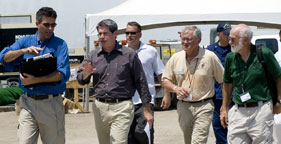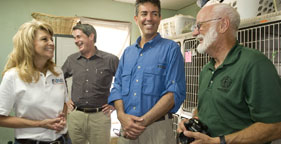Today has been a whirlwind experience -- the second day of extensive field assessment of what's occurring with the oil spill in the Gulf.
 Yesterday, I picked up globules of oil on Orange Beach in Alabama and surveyed evidence of the Gulf spill in Mississippi. Today, hosted by U.S. Sen. David Vitter, we concentrated on Louisiana, starting with a visit to Grand Isle, the only human-inhabited barrier island in the state. We then took a boat ride south to Queen Bess Island, which is a major rookery teeming with brown pelicans and other birds. The island is alive with activity, but it is completely surrounded by a bright orange boom and by a concentric white absorbent boom within it, in order to fend off the oil that has been buffeting the island. The orange boom looked like it was covered in chocolate syrup and the white boom had turned a darker hue, absorbing oil that was on its way to the island. Despite the booms, the rocky shores of the island were covered in oil and we saw birds with oil and many who had not yet felt its effects. When we were there, workers were pulling up the white booms and replacing them with new ones to absorb more oil.
Yesterday, I picked up globules of oil on Orange Beach in Alabama and surveyed evidence of the Gulf spill in Mississippi. Today, hosted by U.S. Sen. David Vitter, we concentrated on Louisiana, starting with a visit to Grand Isle, the only human-inhabited barrier island in the state. We then took a boat ride south to Queen Bess Island, which is a major rookery teeming with brown pelicans and other birds. The island is alive with activity, but it is completely surrounded by a bright orange boom and by a concentric white absorbent boom within it, in order to fend off the oil that has been buffeting the island. The orange boom looked like it was covered in chocolate syrup and the white boom had turned a darker hue, absorbing oil that was on its way to the island. Despite the booms, the rocky shores of the island were covered in oil and we saw birds with oil and many who had not yet felt its effects. When we were there, workers were pulling up the white booms and replacing them with new ones to absorb more oil.
Sen. Vitter and I then went to the one established bird care center in Plaquemines Parish and saw hundreds of birds in various stages of treatment. Some had just arrived and were dark with oil. Others were in tents recovering, cleaned of as much oil as possible. The teams working there are dealing with sweltering heat and working hard. They are in need of more resources to handle the inflow of birds, which are sure to increase in number. They are running a top flight operation, and it is led by the very capable people who run the International Bird Rescue Center.
 From there, we headed to Plaquemines Animal Welfare Society (PAWS), a no-kill shelter which has been dealing with the effects of increased relinquishment of dogs since the spill began. The HSUS last week coordinated the donation of 12.5 tons of pet food to Plaquemines and St. Bernard parishes for distribution to residents impacted by the spill. The outstanding volunteers and staff at the facility gave us a warm greeting, and told us about the new building they plan to move to in the fall.
From there, we headed to Plaquemines Animal Welfare Society (PAWS), a no-kill shelter which has been dealing with the effects of increased relinquishment of dogs since the spill began. The HSUS last week coordinated the donation of 12.5 tons of pet food to Plaquemines and St. Bernard parishes for distribution to residents impacted by the spill. The outstanding volunteers and staff at the facility gave us a warm greeting, and told us about the new building they plan to move to in the fall.
Finally, today, we went to the Audubon Nature Institute, which is treating and caring for oiled turtles. They've taken in about 50 turtles, most of them endangered Kemp's ridley turtles. They are mainly juveniles, and they are swimming around in big tubs reserved just for them. The facility seems to have all systems in place, for spotting turtles in trouble and retrieving and then treating and rehabilitating them. Like us, the staff there fear what they are not seeing -- the turtles in distress no one has spotted yet.
The worst part of the equation is that the Deepwater Horizon continues to spew out thousands of gallons of oil every day -- as Sen. Vitter says, "there's a new oil spill every day." This is a monumental crisis, and it is still unfolding. It is already the largest spill in U.S. history, and it is getting bigger and the oil reaching farther. The fragile Gulf Coast is under siege from this spreading menace of oil. No animals in the ecosystem --above, at, or below the surface -- will escape its effects. I'll be writing more about it in the coming days. Stay tuned.
This post originally appeared on Pacelle's blog, A Humane Nation.
